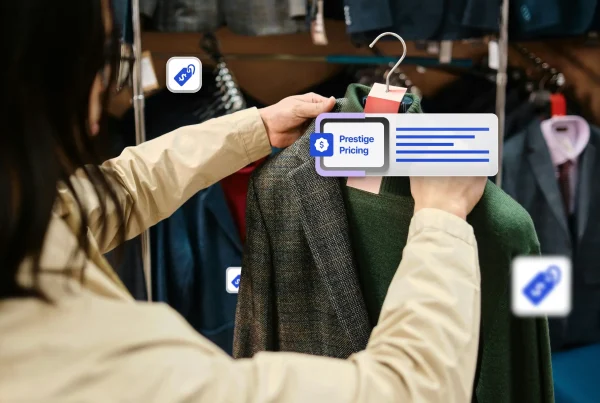Everyone in pricing talks about data. Everyone talks about segmentation, elasticity, and willingness to pay.
But here’s what almost no one asks:
- Why do customers pick the “wrong” plan, even when the value is obvious?
- What makes a $125 offer feel like a steal, only when compared to another $125 offer?
- Why do buyers skip the cheapest option, even when budget is their top concern?
The answer isn’t in the product. It’s in the contrast.
Decoy pricing doesn’t change what you sell, it changes how customers perceive its value. It works because people don’t evaluate offers logically. They evaluate comparatively.
In this article, we’re not just explaining decoy pricing. We’re dissecting how it shifts perception and what strategic pricing leaders need to do to use it without losing trust.
Let’s get into it.
What Is Decoy Pricing?
Decoy pricing is not about adding another specific product. It’s about shaping how customers interpret value.
At its core, decoy pricing is a psychological pricing method that uses an intentionally less expensive offer—a decoy item—to make another option more appealing. This tactic relies on what behavioral economists call the asymmetric dominance effect. In simpler terms: when buyers are presented with three choices, one of which is inferior, they gravitate toward the most reasonable-looking of the remaining two.
That’s the decoy effect—and it can tilt the entire purchasing decision in your favor.
Let’s clarify the decoy pricing definition through a simplified model
- Option A: Basic product, low price, minimal features.
- Option B: Expensive product, rich features.
- Option C (Decoy): Similar price options to Option B, but with fewer features than Option B and only slightly more than Option A.
Customers now perceive Option B as a smart choice—not because its value changed, but because Option C makes it look like a better deal.
That is the power of a pricing decoy.
It’s important to note: the decoy product is not there to sell. It exists to drive attention toward the particular product, the one that offers higher margin, better value, or better alignment with your business goals.
In structured pricing models, such as software tiers, subscription plans, or bundled services, this decoy pricing strategy helps create a mental anchor. It introduces a reference point that shifts perception without changing the offer itself.
That’s why decoy pricing is not a discount tactic. It’s a positioning tool.
It works because buyers rarely evaluate price in absolute terms. They rely on relative comparisons. And when you control the comparison, you influence customers.
Examples of Decoy Pricing
The strength of a decoy pricing strategy lies in its subtlety. The decoy option is not random—it’s precise, deliberate, and designed to shift attention. Here are several decoy effect pricing examples that demonstrate how this method works across industries.
1. The Subscription Model: A Classic Decoy
The Economist once offered three pricing tiers:
- Web-only: $59
- Print-only: $110
- Print + Web: $125
Almost no one chose the print-only option. It existed as a decoy price. Its sole purpose was to make the combo package—the real target product—look like a no-brainer. When the decoy item was removed, more people selected the cheaper web-only plan. The presence of the decoy drove higher-value conversions.
This is a premium decoy pricing example, where the decoy and the premium are priced equally, but the decoy is inferior. It reframes the decision-making process entirely.
2. Fast Food & Bundle Pricing
At many fast-food chains, you’ll find this structure:
- Small drink: $1.59
- Medium drink: $1.89
- Large drink: $1.99
The medium size is the decoy. It exists to make the large seem like an excellent deal. The extra volume comes at no extra cost, so customers shift upward. The decoy pricing strategy works here because of the asymmetric dominance of the medium size—it is priced similarly but delivers less value.
This type of decoy effect pricing is deeply effective in environments where decisions are fast and value is judged quickly.
3. SaaS and Tiered Pricing
SaaS companies often use a three-tier model:
- Basic: $29/month
- Professional: $59/month
- Enterprise (Decoy): $79/month
The Enterprise plan may offer features irrelevant to 90% of users. It’s positioned to drive demand for the Professional plan by comparison. The decoy pricing method here doesn’t target sales at the top—it influences middle-tier adoption, where conversion and retention are strongest.
This is another decoy product pricing strategy that improves margin without changing the core product.
4. Luxury Retail: Strategic Framing of Different Price Anchors
Luxury brands sometimes place an ultra-premium product in-store, not to sell it, but to make high-end items seem more accessible. A $4,000 handbag next to a $1,900 model makes the latter appear reasonable. That’s a decoy pricing example used to anchor perception in high-ticket categories.
The decoy is not there to move units. It’s there to change the reference point and elevate the perceived value of the item meant to sell.
In each example, the presence of the decoy changed how buyers viewed the actual offer. The decision was not only about price. It was about comparison, attraction effect, and the way value was presented.
This is what makes decoy pricing so effective—it guides the decision without altering the core product.
Also Read: Surge Pricing Explained: Risks, Strategy, and How to Get It Right
How Does Decoy Pricing Strategy Work?
At the heart of decoy pricing is a simple truth: people don’t know how to judge value in isolation. They rely on context.
This is where the decoy effect becomes powerful. It works by exploiting a specific type of cognitive bias called asymmetric dominance, where one option dominates a third, inferior option, while also appearing more attractive than a cheaper but limited alternative.
Let’s break this down.
The Role of the Decoy Item
In a typical decoy pricing strategy, you have three options:
- Low-priced, low-value
- High-priced, high-value
- Decoy option – priced close to the high-value offer but offering significantly less
The decoy option is not there to win. It’s there to make the high-value option appear as the logical, balanced, or safe choice. This is known as the attraction effect—the target product becomes more appealing in the presence of the decoy.
It’s not just a trick. It’s a strategic shift in how people evaluate price and value.
The Consumer Psychology Behind the Strategy
Customers often rely on reference points when making decisions. They don’t ask, Is $59 worth it? They ask, Is $59 better than $29 or $79 for what I get?
By introducing a decoy, you anchor attention. You create contrast. You turn the higher-priced or mid-tier product into the most reasonable, value-aligned choice.
This is why decoy pricing strategies work so well in tiered pricing, subscription models, and bundle offerings. When used correctly, they can:
- Drive movement toward higher-margin plans
- Reduce decision friction
- Increase perceived fairness of pricing
- Frame your offering as balanced and well-structured
All without discounting.
Why the Decoy Effect Holds Up
The effectiveness of decoy pricing depends on three things:
- The decoy must be close enough in price to the target product to encourage comparison
- It must be inferior, but not irrelevant
- It must feel like a real choice, even if it’s rarely selected
This creates what pricing experts call a compromise effect, where the middle option becomes a safe choice between extremes. Often, that’s the product you want customers to buy.
When the Strategy Fails
Decoy pricing is not immune to failure. When the decoy is too obvious or too disconnected from the customer’s goal, the effect breaks down. Modern buyers are more informed. They notice when they’re being steered too aggressively.
This is why effective decoy pricing requires insight. You need to understand your customer, your pricing architecture, and your product’s actual value.
Pros and Cons of Decoy Pricing
Decoy pricing is not a pricing trick—it’s a pricing lens. When used correctly, it helps structure how customers perceive value, not just how they choose between price points.
But there’s nuance here. The decoy effect operates within a narrow margin of behavioral predictability. If the execution drifts even slightly—if the decoy becomes too obvious, too weak, or too artificial—the entire decoy pricing strategy collapses.
Let’s go deeper than the typical surface-level advice.
Pros of Decoy Pricing
Enhances Value Perception Without Altering the Product
One of the most overlooked benefits of decoy pricing is that it creates perceived differentiation without needing a product change. You shift how customers judge value by controlling the comparison point—your decoy, not the product itself. This is especially effective when improving margin without investing in feature development.
Improves Decision Clarity, Not Just Conversion
A well-placed decoy item helps customers understand your offer faster. When customers feel less cognitive strain, they convert with greater confidence and lower refund or churn risk.
This is why decoy pricing strategy works so well in SaaS and financial services. It supports decision-making clarity, not just consumer behavior bias.
Serves as a Low-Risk Testing Layer
The presence of the decoy allows you to test willingness to pay, without directly testing the target product. You can introduce a pricing decoy, watch buyer movement, and gather clean behavioral data before adjusting your real offer. In effect, the decoy becomes a proxy for price elasticity analysis.
Cons of Decoy Pricing
Decoy Pricing Can Undermine Tier Integrity
In tiered models, especially in enterprise or B2B, a poor decoy can erode the logic of your entire price architecture. If customers spot the decoy and believe it was added to manipulate their decision, it introduces doubt about your pricing as a whole.
This isn’t just a lost sale—it’s lost confidence in your brand.
Cognitive Load Backfires in Complex Offers
While the decoy pricing method simplifies choices in limited-option environments, it can be overwhelming in complex ones. Adding a decoy option to an already dense offering (e.g., a financial product suite or medical device bundle) adds mental friction, not clarity.
In these cases, decoy pricing needs to be paired with guided selling tools or visual comparison frameworks, or skipped entirely.
Risk of Pattern Recognition Among Repeat Buyers
In industries with high customer lifetime value or frequent renewals (SaaS, telco, insurance), customers eventually notice patterns. If they see the same decoy structure reused over time, it creates pricing fatigue—or worse, triggers the perception that pricing is engineered to exploit rather than serve.
This is why decoy pricing strategies must evolve. The decoy that worked this quarter may need to disappear the next.
Not All Products Can Sustain a Decoy Tier
Here’s a reality most don’t mention: not every product has the margin flexibility to carry a decoy. If your COGS is high, and the decoy adds operational cost or inventory burden, it’s not worth the positioning benefit.
In physical goods, a decoy pricing strategy might require non-stocked SKUs or virtual-only variants. Without operational efficiency, the strategy fails on economics, not psychology.
Bottom Line for Pricing Leaders
The most effective use of decoy pricing doesn’t focus on the decoy—it focuses on the story the decoy enables.
Done right, it creates alignment between product value, price architecture, and customer perception. Done poorly, it adds noise, creates doubt, or makes your pricing feel engineered rather than intuitive.
Also Read: What Is Price Matching? How Price-Match Guarantee Helps Retailers
How to Integrate Decoy Pricing Into Your Business
Integrating decoy pricing into your business isn’t about adding a third option. It’s about designing a structured choice architecture that aligns with customer psychology and business strategy.
If the decoy exists just to exist, it’s noise. However, if it’s engineered with intention, anchoring value, guiding perception, and supporting margins, it becomes a valuable asset. Here’s how to integrate decoy pricing strategies correctly.
1. Start with a Value Hierarchy, Not Price Tiers
Before introducing a decoy option, define a value hierarchy across your products or services. What does your customer actually care about—speed, scale, simplicity, features, or support?
The decoy product should expose the weakness in the low-end tier while reinforcing the strength of the offer you want to sell. Without a clear hierarchy, even the best pricing decoy will fall flat.
Ask:
- What features would customers willingly trade off?
- What makes the middle-tier look like the “smart” option?
- What cost-to-benefit imbalance would seem illogical in the decoy?
2. Anchor the Decoy to the Margin Target
The decoy effect works best when your target product is high-margin. But that doesn’t mean pricing blindly. The decoy price should sit close enough to the target to spark comparison, but far enough from the base to frame it as inferior.
Example:
- Base: $49/month – limited value
- Decoy: $89/month – confusing or incomplete
- Target: $99/month – clear value, well-rounded
This structure makes the target product seem like a near-premium choice at an efficient cost. The decoy pricing method should never cannibalize; it should defend your best-positioned offer.
3. Design the Decoy Around Perception, Not Features
Don’t just remove features to create a decoy. Frame the decoy item around user perception. That includes how the product is named, how benefits are worded, and what the customer emotionally reacts to.
A decoy should raise a subtle objection:
“Why would I pay nearly the same for something with less?”
That friction leads the buyer toward the more balanced, higher-priced option.
In retail, this could be a product with a similar design but visibly lower build quality. In services, it could be a plan with support delays or usage limits. In all cases, perception is the lever.
4. Test in Controlled Environments First
Before deploying decoy pricing across your full customer base, run small-scale experiments. A/B test three-option layouts. Use heatmaps or funnel tools to monitor engagement with the decoy. If buyers ignore it—or worse, select it—your structure needs refinement.
Important metrics to watch:
- Drop-off after pricing view
- Conversion distribution across tiers
- Decoy engagement (hover, comparison clicks, time on section)
Decoy pricing is most powerful when the decoy is ignored, but still influences selection.
5. Use Transparency to Build Trust
This is where most pricing blogs stay silent—and where pricing leaders must lead.
If your customers sense that a decoy option was added purely for manipulation, trust erodes. Instead of hiding it, frame the decision structure. Use visual comparisons, callouts like “best value,” or even explain who each plan is for.
Decoy pricing works best when customers feel they’re making a smart, informed decision, not being funneled into one.
In short: structure the journey, but respect the buyer.
When Not to Use Decoy Pricing
Do not implement decoy pricing when:
- Your offer is commoditized, and simplicity is key
- You lack sufficient margin to support a third-tier presentation
- The customer base already understands your pricing too well
- Your sales team can’t explain the difference clearly
In these cases, a decoy pricing strategy creates more confusion than clarity and should be replaced with direct segmentation or personalized pricing.
Design the Outcome, Not the Option
The goal of implementing decoy pricing is never to make the decoy perform. It’s to ensure that the target product becomes the obvious, high-confidence choice.
Start with a margin strategy. Anchor to behavioral bias. End with trust.
Only then does the decoy pricing strategy work at scale and support long-term business health.
Final Thoughts
Decoy pricing is not about adding complexity—it’s about shaping decisions through contrast. When structured deliberately, it helps customers navigate options with clarity and confidence, guiding them toward higher-value choices without altering your product. More than a tactic, it is a lens to expose gaps in your pricing logic and reveal how your offers are truly perceived.
If you’re ready to move beyond static models and build pricing that adapts, aligns, and scales, AI-native solutions can help you do it with precision, speed, and control. Implement decoy pricing—and every other modern pricing method—smarter, faster, and with measurable margin impact through Impact Analytics PriceSmart™.
Frequently Asked Questions
When should I avoid using a decoy?
When your pricing is already simple, your margins are tight, or when adding another tier creates confusion instead of clarity.
What makes a good decoy?
Proximity in price, clear inferiority in value, and just enough believability. It should make buyers say, “Why would I pick that?”
Can decoy pricing work for physical products?
Yes, especially in retail and food. Use similar-looking options with slight feature downgrades to guide shoppers to your target SKU.
Is the decoy supposed to convert?
No. Its job is to steer attention, not drive conversions. If people start choosing it, it’s too strong, or your tiers aren’t clear enough.





